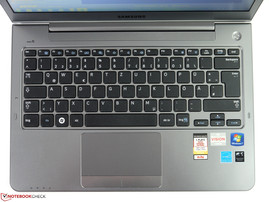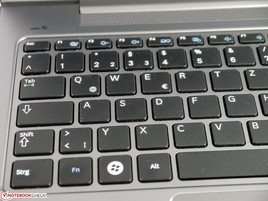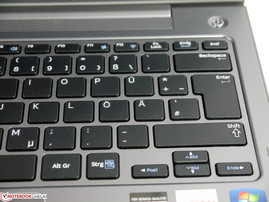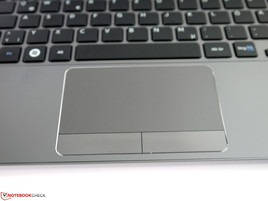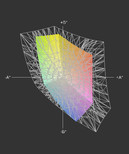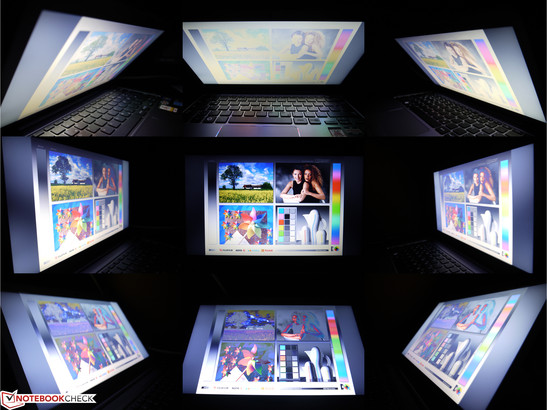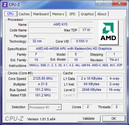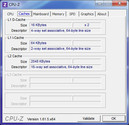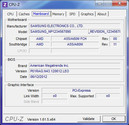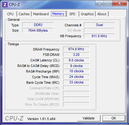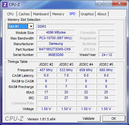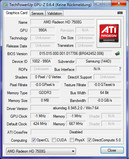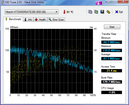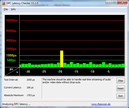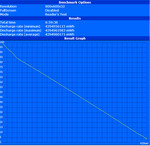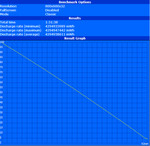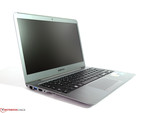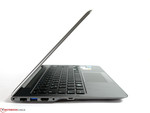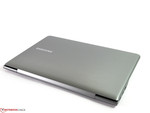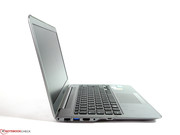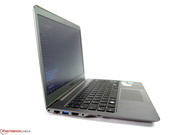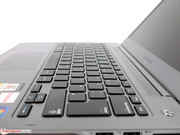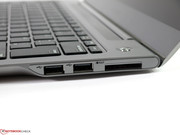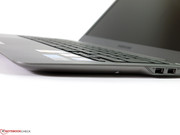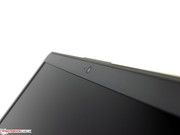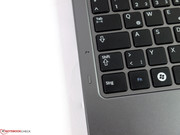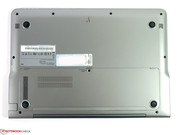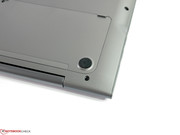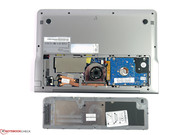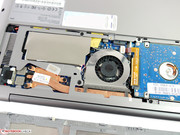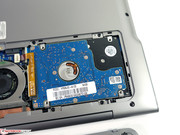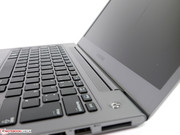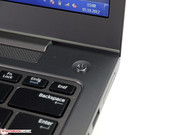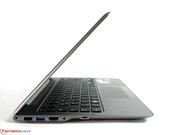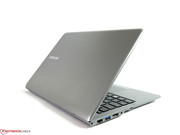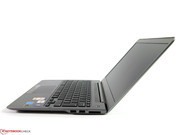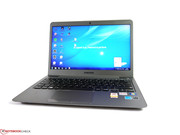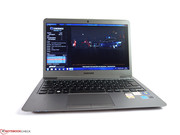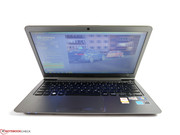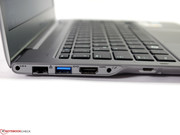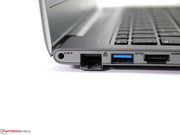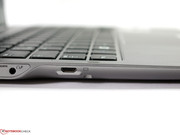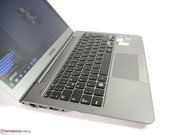Review Samsung Series 5 535U3C Notebook

We tested the 530U3B-A01DE (Sandy Bridge) and 530U3C-A01DE (Ivy Bridge) Intel models from the Series 5 in March and June. Both made an overall good impression, which nevertheless could not hide the one or other shortcoming. Therefore we will check whether Samsung has made improvements or whether you still have to make a few compromises in the following review. Our test device features AMD's A6-4455M energy-saving processor with an integrated Radeon HD 7500G graphics, 8 GB of RAM, a 500 GB hard drive and a matte 13.3 WXGA screen. The current street price is just under 600 Euros (~$777) and undercuts the similarly equipped Intel version by over 100 Euros (~$129).
Case
Samsung apparently has not modified the casing. We do not see any difference compared with the previously tested models and that regrettably includes the drawbacks. The casing is easily dented above and below the keyboard and the display's hinge is still too weak to prevent the screen from rocking. Otherwise, the plastic casing's workmanship is good - even gaps, accurately fitting components and an easy to clean surface represent the targeted price range aptly. We weighed 1.48 kg rather than the 1.52 kg specified by the manufacturer. Along with the 280 g PSU and a thin sleeve, it would be possible to remain just below 2 kg on the go.
Connectivity
The available interfaces and their positioning have also been adopted without changes to the AMD model. The distribution of the ports at the rear and the relatively opulent interface variety for a notebook of this size is still pleasing. On the other hand, it is a disadvantage that inserted memory cards protrude out of the case by about two-thirds and the gap between both USB ports on the right is too tight. However, the ports are impressive in terms of performance. USB 3.0 transferred data with up to 169 MB/s via an external SSD, USB 2.0 30.2 MB/s and the card reader moved data from our SDHC card with 17.8 MB/s. Samsung does not include any additional accessories. There is only a recovery DVD for restoring the system in the box. That facilitates the task although our test device did not feature an optical drive.
Communication
Wi-Fi 802.11 abgn, Gigabit LAN and Bluetooth 4.0 cover the usual scope for connecting to integrated or wireless peripherals. The quality of the built-in 1.3 MP webcam is absolutely sufficient for video calls. However, mobile internet is not possible since no models feature a 3G modem.
Maintenance
The working memory, hard drive and fan can be accessed easily via the big cover on the bottom. The memory cannot be expanded since the maximum specified by Samsung is inserted via a soldered 4 GB RAM module in one bank and an inserted 4 GB RAM module in the second.
Warranty
Samsung includes a 24 month manufacturer warranty. An upgrade to 36 months for 60 Euros (~$77) or 48 months for 100 Euros (~$129) must be acquired within 90 days after purchase.
Input Devices
Keyboard
The chiclet keyboard, featuring 81 keys in the usual 19 mm grid, offers overall large keys and a good pressure point. However, it recoils a bit while typing. The arrow keys, which may be too small for some users, particularly stand out with a too slight, vertical gap between the arrows. A keyboard backlight is not available, but the keys' lettering presents high-contrast with exception of the FN combinations.
Touchpad
The touchpad is big, offers good gliding traits and supports common multi-finger gestures. The touchpad keys' click noise could be a bit more restrained, but it is not a disturbing factor except in extremely quiet surroundings.
Display
The 13.3-inch screen from SEC with a WXGA resolution has a different model number, but is otherwise comparable with the Intel versions in many things and seems to simply be from another production batch.
The brightness ranges from 261 cd/m2 in the lower right corner up to 342 cd/m2 in the left center. An average of 293 cd/m2 is reached by measuring at nine points, which is higher than the March model and lower than the June model. Basically, we come quite close to the manufacturer's specification of 300 cd/m2, although we have to accept a brightness decrease from the left to the right in the test device. This also leads to a moderate illumination of 76%, which is only visible on dark monochrome pictures and thus should be irrelevant for most of the target group's practical application fields.
| |||||||||||||||||||||||||
Brightness Distribution: 76 %
Center on Battery: 305 cd/m²
Contrast: 136:1 (Black: 2.24 cd/m²)
37.78% AdobeRGB 1998 (Argyll 3D)
54.8% sRGB (Argyll 3D)
36.54% Display P3 (Argyll 3D)
Although the ascertained brightness rates alongside the matte surface result in good outdoor usability, the contrast of 136:1 is disappointing. Weak colors, unsaturated black and consequently a not very effective reproduction of pictures and movies are the result of the installed standard screen. This is not very surprising since only 55% of the sRGB color spectrum is covered.
Performance
The feature of our test device is that not Intel's performance components are used, but AMD equipment like the chipset (AMD A70M), graphics and processor, is installed. It is also unusual that AMD's energy-saving A6-4455M processor is built in. It features a maximum TDP (thermal design power) of 17 watts, including the Radeon HD 7500G graphics unit, and is supposed to score in runtime and noise development in Samsung's slim 535. 8 GB of working memory is already the maximum and the conventional 500 GB hard drive supplies enough storage for many application fields.
Processor
AMD's A6-4455M dual-core processor belongs to the latest Trinity generation. In addition to the CPU, it also harbors the memory controller and GPU in its casing and generally can serve with a clock speed of 2.1 to 2.6 GHz. Hyper threading technology, so support via additional virtual computing cores in order to process several threads at once, is not a feature of this AMD processor.
Although the nominally rather high clock rate suggests a competitive performance at least in single-thread applications, the results clearly lag behind Intel's similarly clocked Core i5-3317U CPU in Samsung's Series 5 530U3C-A01DE. For example, 2658s versus 764s in SuperPi's 32M calculation and in Cinebench R10 64bit (single) merely 2172 points rather than 4432 points are reached. When all threads are loaded at the same time, AMD's A6-4455M accomplishes 4254 rather than 7991 points in Cinebench R10 64bit multi-core and needs 1950s rather than 927s in wPrime's 1024m test.
That is a performance difference of roughly 100%, which is not only measureable but is also noticed clearly when performance-hungry tasks have to be managed. CPU-Z and AMD's System Monitor at most displayed the default clock of 2.1 GHz during the tests. Thus, Turbo mode is not enabled and the specified maximum of 2.6 GHz proves to be useless in this model. Since we also observed this behavior in the Intel model, it seems Samsung omits the Turbo mode on purpose in this model range in order to keep the temperatures in the slim case within a limit. Approximately 20% higher results are achieved by Samsung's 14-inch 535U4C (with Turbo) in the CB single-thread tests.
Our comprehensive database about the performance of processors can be found here.
| Cinebench R10 | |
| Rendering Single CPUs 64Bit (sort by value) | |
| Samsung 535U3C | |
| Samsung 535U4C | |
| Samsung 530U3C-A01DE | |
| Rendering Multiple CPUs 64Bit (sort by value) | |
| Samsung 535U3C | |
| Samsung 535U4C | |
| Samsung 530U3C-A01DE | |
| Cinebench R11.5 | |
| CPU Single 64Bit (sort by value) | |
| Samsung 535U3C | |
| Samsung 535U4C | |
| Samsung 530U3C-A01DE | |
| CPU Multi 64Bit (sort by value) | |
| Samsung 535U3C | |
| Samsung 535U4C | |
| Samsung 530U3C-A01DE | |
System Performance
The section "System Performance" deals with the system as a whole, i.e. how the single core components work together. In addition to the processor's performance, the RAM configuration, storage devices and of course the graphics card play a role. While every new laptop can deal with basic tasks, such as browsing, word processing, playing videos and checking emails, a somewhat stronger system is needed for higher demands, like image editing and converting.
The standard benchmarks, such as PCMark Vantage (2561 points) and PCMark 7 (1368 points), show that the performance is clearly higher than that of netbooks (e.g. Asus Eee PC 1011CX), but over half as weak as the Series 5 alternative featuring Intel's Core i5-3317U CPU. As long as you are not planning to perform loads of conversions, the above mentioned tasks can be performed comfortably and easily.
However, if you want to occasionally convert a bit of music or videos into a different format, you will have to count with a longer timeframe than would be the case with stronger processors and graphics chips. iTunes conversion from MP3 to AAC format was performed in 17.9x speed and the conversion of our two test videos took roughly twice as long as with the AMD's A6-3420M processor.
| PCMark Vantage Result | 2561 points | |
| PCMark 7 Score | 1368 points | |
Help | ||
Storage Devices
In contrast to Samsung's Series 5 530U3C-A01DE, Hitachi's conventional hard drive is not supported by a 24GB Express Cache. The transfer rates (max. 110 MB/s) and the access times (21 ms) are within the usual range and correspond to the current expectations placed on hard drives featuring a revolution speed of 5400 rpm. Should speed be more important than storage, replacing the HDD with a solid state drive could increase routine speed noticeably. A comparison of storage devices can be found in our extensive HDD benchmark list.
Graphics Card
Until now, integrated graphics solutions from AMD and Nvidia often had an advantage over the competition from Intel. This is only true to an extent in this case, even when we only compare the graphics performance directly because the differences between the Series 5 alternatives are too insignificant. On the one hand, the processor integrated graphics solutions are innately not very strong. On the other hand, our Radeon HD 7500G graphics core does not reach the maximum clock rate of 424 MHz, but stays at 200 MHz, particularly with simultaneous CPU load, according to AMD's System Monitor and GPU-Z. At least the performance is not throttled even more on battery power. It works just like in AC-mode with the right pre-settings in AMD's Powerplay settings.
As to the benchmarks, the results of both models are basically quite close. It is only striking that the AMD configuration clearly wins Cinebench R11.5 OpenGL shading with 20.5:13.7 points but then is defeated by Samsung's Series 5 530U3C-A01DE (Intel HD Graphics) in 3DMark Vantage with 2410:2854 points. This might be because OpenGL Shading is not quite as CPU-heavy and the graphics card can run on its full clock.
In practice the measurable differences are hardly noticed. Both models can render Full HD videos smoothly and 3D graphics power is rather secondary for Office and other application fields. Photoshop filters that use OpenCL are still very manageable and, as we noted in "System Performance", the graphics chip is usable for converting, providing that the software supports it. It again gets interesting in games since certain obstacles have to be tackled so that the user perceives the track as smooth.
A comprehensive performance comparison can be found in our mobile graphics cards benchmark list.
| 3DMark 06 Standard Score | 4903 points | |
| 3DMark Vantage P Result | 2410 points | |
| 3DMark 11 Performance | 638 points | |
Help | ||
Gaming Performance
A shared graphics memory, a fairly low GPU maximum clock speed of 424 MHz and "merely" 256 shader cores are not the best conditions for a good gaming performance. Then there is the weak CPU that does not exactly improve things. We selected a few games that only cover a small range, but still allow insight about how well our test device really copes in this regard. As our result table shows, low quality settings and a low resolution are possible when you do not want to watch a slide show. It seems that only the restrained World of Warcraft enables a bit more. An extensive comparison chart about the gaming performance of graphics cards can be found here.
| low | med. | high | ultra | |
|---|---|---|---|---|
| World of Warcraft (2005) | 112 | 67 | 24 | |
| StarCraft 2 (2010) | 37 | 14 | ||
| Anno 2070 (2011) | 38 | 16 | ||
| Diablo III (2012) | 40 | 27 | 21 |
Emissions
System Noise
Samsung's 535 noise development has to be described as extremely pleasant. The very quiet fan remained completely disabled in Silent Mode during low load and the quiet hard drive noise of 31.6 dB(A) was audible when the storage device was being accessed. If an SSD was installed, the test model would be silent. The system even stayed agreeably quiet with 32.1 dB(A) when several browser tabs were opened or while uploading image files or installing programs. The fan noise first increased to 39.8 dB(A) to 42.3 dB(A) during demanding tasks, such as converting music and videos or gaming. However, it is never annoying due to the restrained noise characteristics. We did not ascertain high-pitched noises, whistling or a hectic fan management in our test device.
Noise level
| Idle |
| 29.8 / 29.8 / 32.1 dB(A) |
| HDD |
| 31.6 dB(A) |
| Load |
| 39.8 / 42.3 dB(A) |
 | ||
30 dB silent 40 dB(A) audible 50 dB(A) loud |
||
min: | ||
Temperature
The fan's low activity in Silent Mode causes the casing to heat up to approx. 40°C. That is not unpleasant or critical, but it is very noticeable in some places and thus far from being a cool laptop. However, it is possible to select a constantly whirring fan in the Eco Mode settings, which lets the case's temperature drop by 2°C. During load the casing reached a temperature of up to 52.2°C at the vent and up to 47.7°C on the bottom in the same area. That is quite warm and shows that the cooling system works at the limits of its possibilities during longer periods of load. Samsung likely did not enable a higher CPU clock in this series (disabled Turbo) for good reason.
(-) The maximum temperature on the upper side is 52.2 °C / 126 F, compared to the average of 35.9 °C / 97 F, ranging from 21.4 to 59 °C for the class Subnotebook.
(-) The bottom heats up to a maximum of 47.7 °C / 118 F, compared to the average of 39.3 °C / 103 F
(±) In idle usage, the average temperature for the upper side is 33.1 °C / 92 F, compared to the device average of 30.8 °C / 87 F.
(+) The palmrests and touchpad are cooler than skin temperature with a maximum of 30.9 °C / 87.6 F and are therefore cool to the touch.
(-) The average temperature of the palmrest area of similar devices was 28.2 °C / 82.8 F (-2.7 °C / -4.8 F).
Speakers
The sound output comes from two small speakers on the bottom and only supplies the most necessary. You do not want to torture yourself for a long time with a very treble-heavy and tinny sound that lacks real mid-ranges and bass. Headphones or external speakers perform miracles in a direct comparison. They enhance the sound quality immediately and will quickly end up as accessories in your laptop case. If you require a headset for video calls or other tasks, you will only find a combo audio jack. Headsets featuring 2 jack plugs cannot be used and will have to be replaced.
Battery Life
Power Consumption
The power consumption at the mains ranges from a minimum of 7.7 watts up to a maximum of 41.8 watts. Even up to 42.4 watts is possible when the battery is being charged at the same time. While the minimum consumption indicates that AMD manages the low load consumption well, the maximum power requirement seems to be a bit high for a system featuring a 17 watt TDP APU. Especially since the PSU is specified with a nominal power usage of merely 40 watts. Another indication that Samsung purposely omitted Turbo in the CPU is that the maximum is already permanently being squeezed out during full load. The quite optimistic power consumption display in Samsung's Easy Settings should not be trusted too much. The displayed rates differ by more than 10 watts compared to what our power meter recorded.
| Off / Standby | |
| Idle | |
| Load |
|
Key:
min: | |
Battery Runtime
In addition to the power consumption, a high battery capacity is needed for a good battery runtime. Samsung opted for a permanently built-in alternative in its slim Series 5 models. In our case, it still features a good capacity of 45 Wh. A version featuring a 66 Wh battery is also listed in the data sheet.
Almost 7 hours of runtime was reached in BatteryEater's Reader's test (minimum screen brightness, all off, energy-savings mode), which results in a power consumption of 6.4 watts. This is due to certain power saving features of some components on battery power, among other things. We did not ascertain longer battery runtimes when Samsung's Eco Mode was selected. The Eco Mode did not exhibit a runtime plus opposed to the system's energy-saving mode in our Wi-Fi test where the brightness was set to approx. 150 cd/m2 and enabled Wi-Fi module. On the other hand, the "Optimized Samsung Mode" did not have an apparent impact on the system's performance either. We recorded virtually identical performance and runtime rates compared with Windows' high-performance profile.
The battery runtime in BatteryEater's Classic test (maximum brightness, all on) was 92 minutes with a rest capacity of 3%. This adds up to a consumption of approx. 30 watts. We played a movie file directly from the hard drive in our video test because there is no optical drive. This was possible for over 2 1/2 hours using energy-saving mode, disabled Wi-Fi and maximum brightness.
Verdict
Samsung's Series 5 scion featuring AMD technology clearly lines in behind the Intel-based versions in terms of performance and is only half as fast in many cases. The somewhat better graphics performance in the subareas does not help here either. It does not have a positive impact on the subjective speed disadvantage in practical use.
In return, we did not ascertain any differences to the Intel model regarding casing quality, connectivity, screen or keyboard qualities. There may be the odd, minor production-related deviations, but they are not connected to the single processor configuration.
The battery runtimes do not reach the times of Samsung's Series 5 530U3C-A01DE (Intel) despite the weaker computing power, but they are nevertheless quite useable and enable working away from the mains for about 4 hours.
The casing's temperature and noise development are roughly on a par with the Intel model. However, the AMD combination is a bit quieter and virtually works silently in little load.
For currently just under 600 Euros (~$776), you have to accept lower computing power and approx. 1 hour less of practical runtime in Samsung's Series 5 535U3C (AMD). In return, you get a lightweight, slim and above all quiet subnotebook that is well suitable for many common home office tasks.








